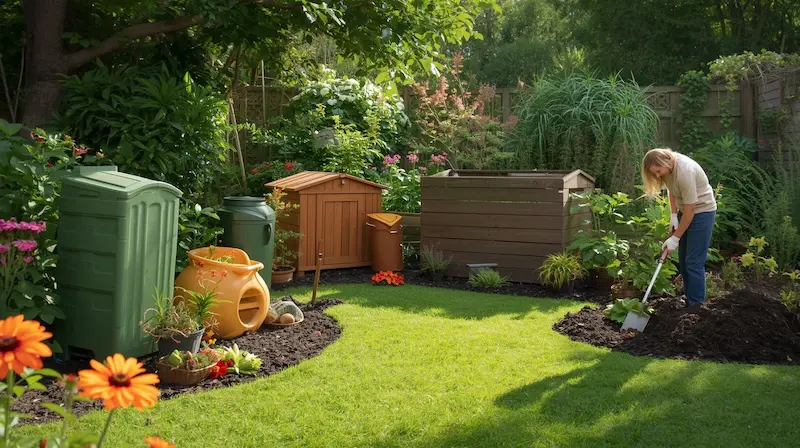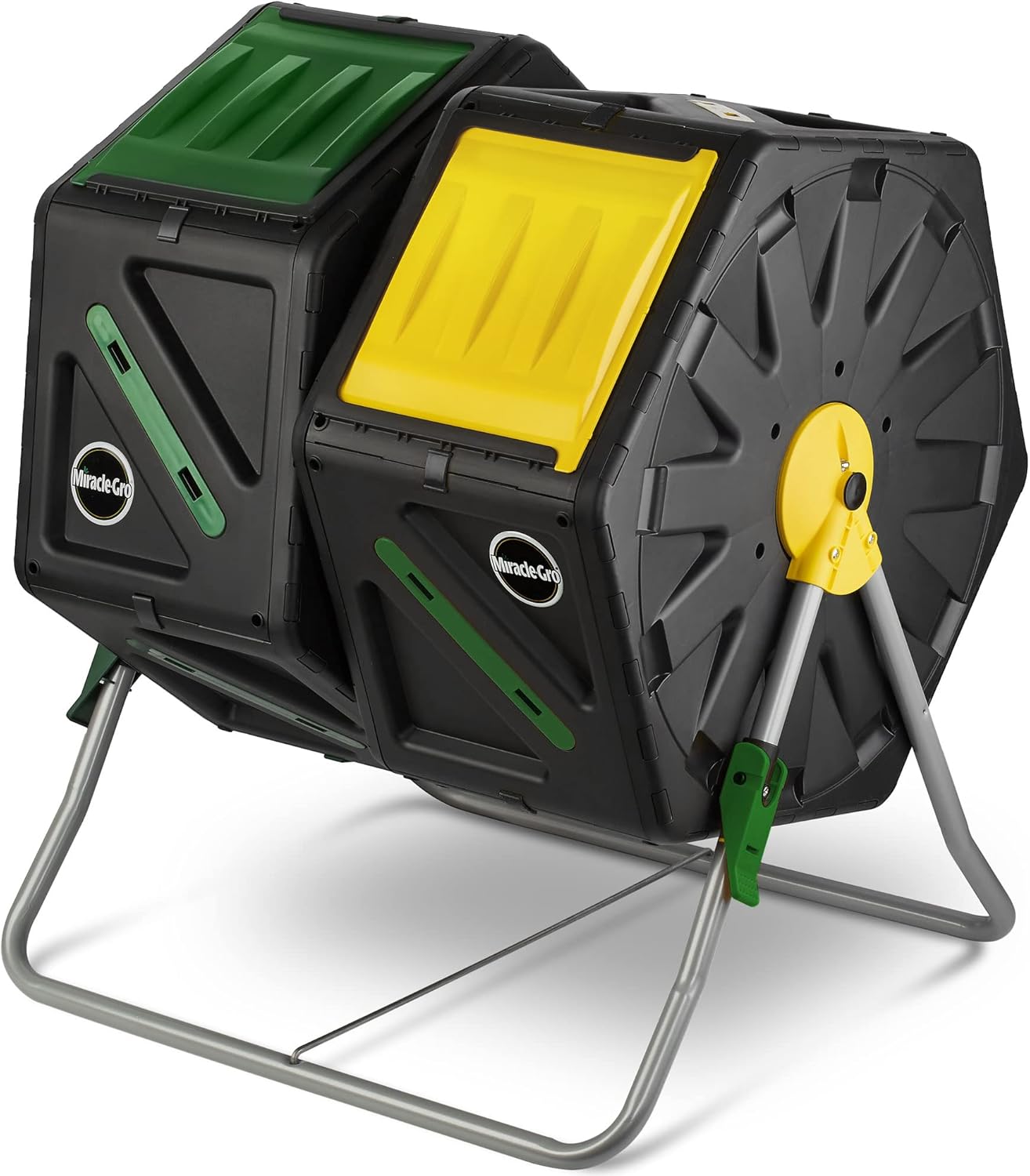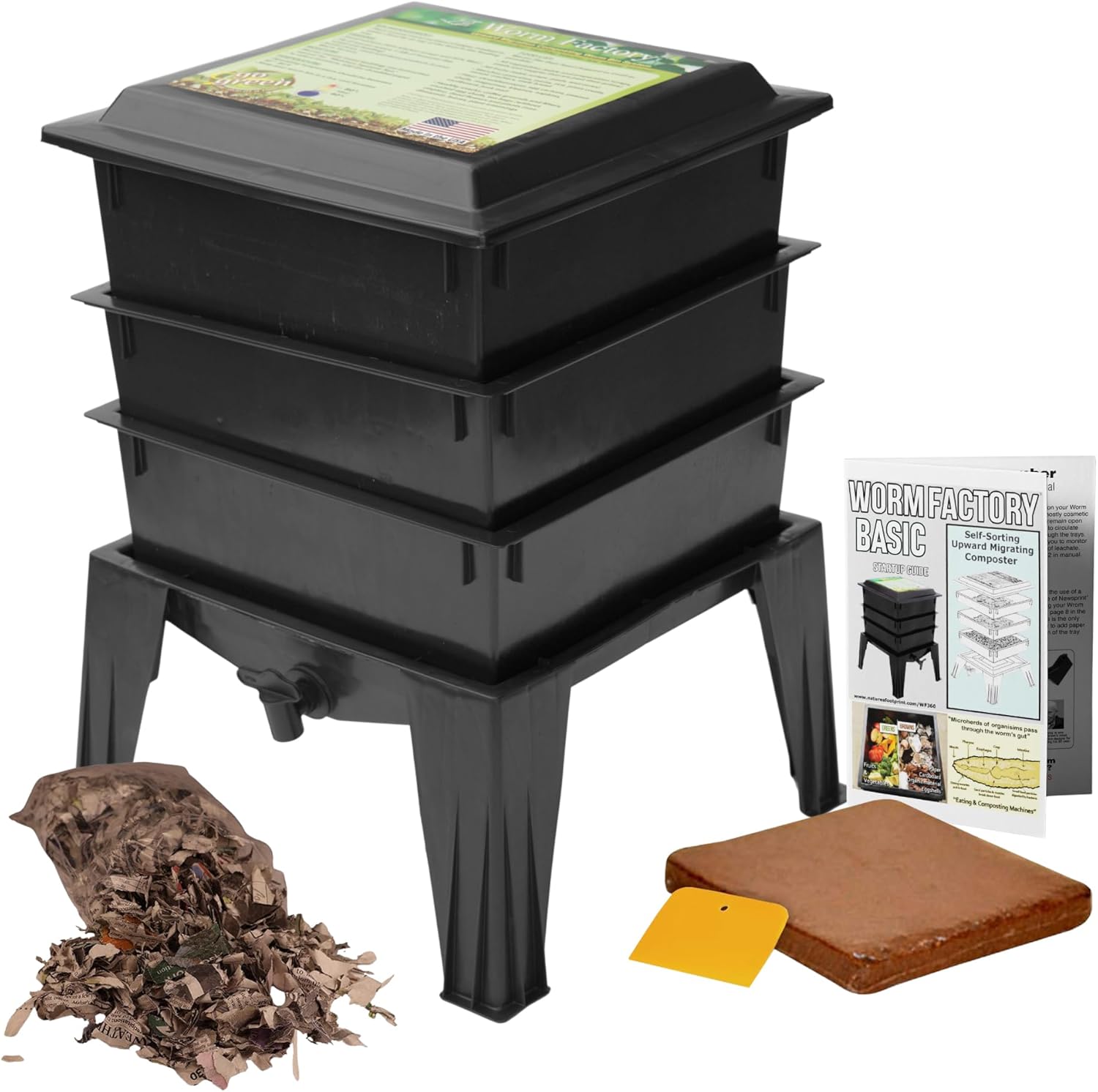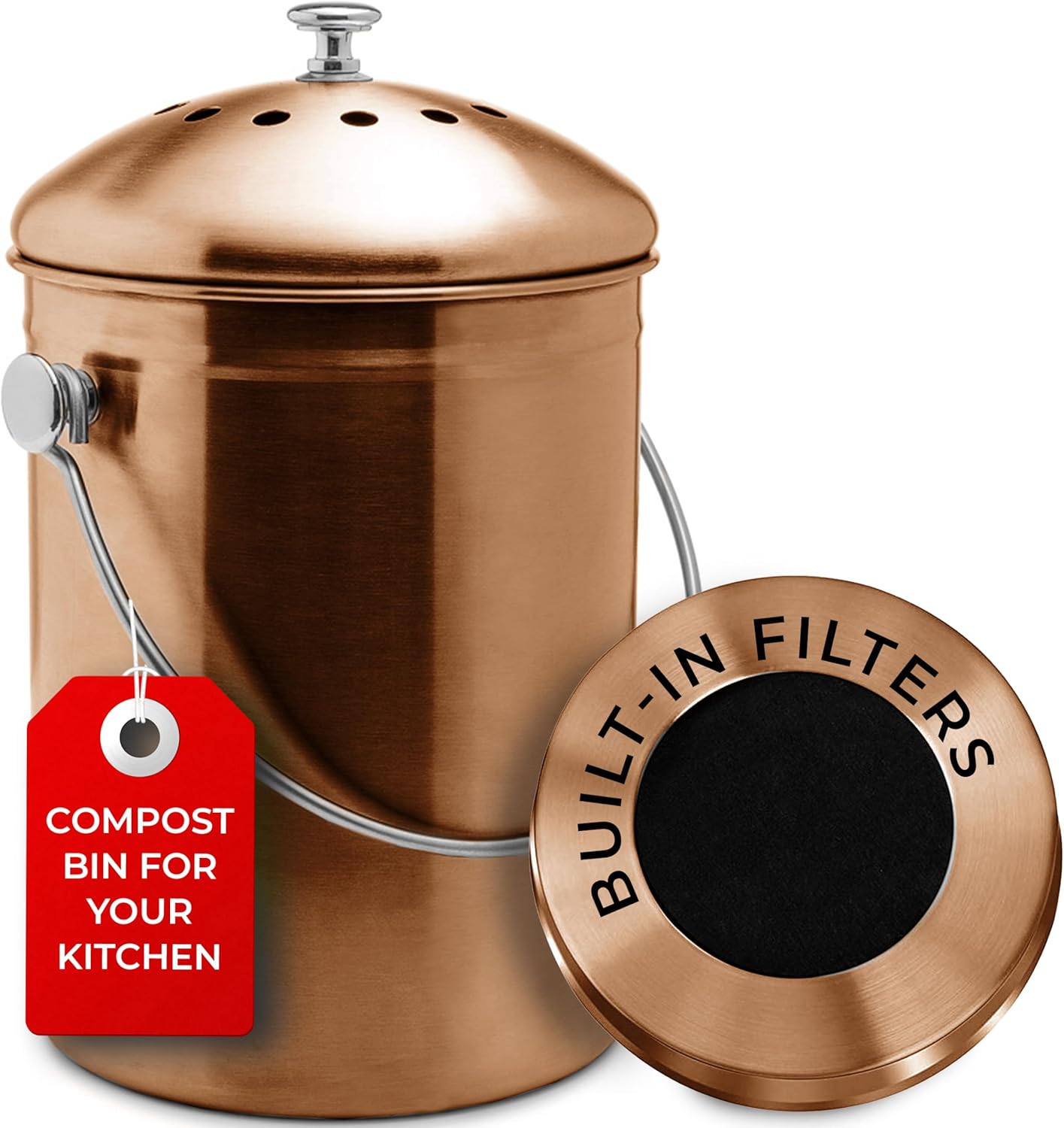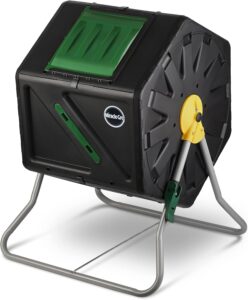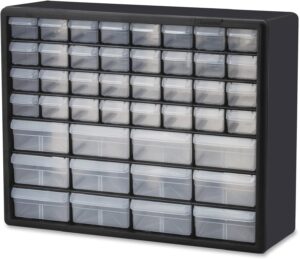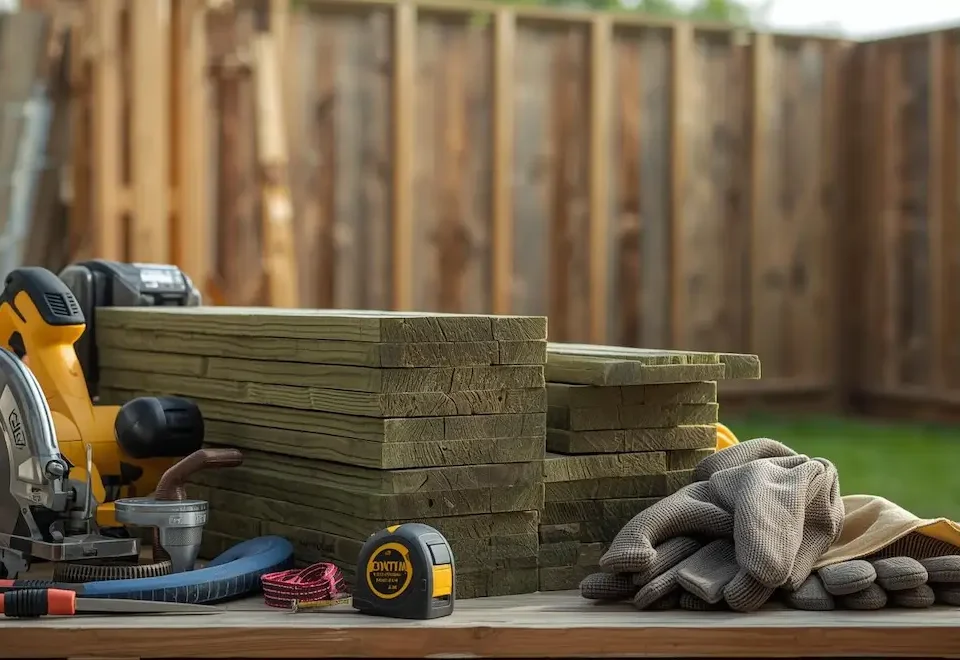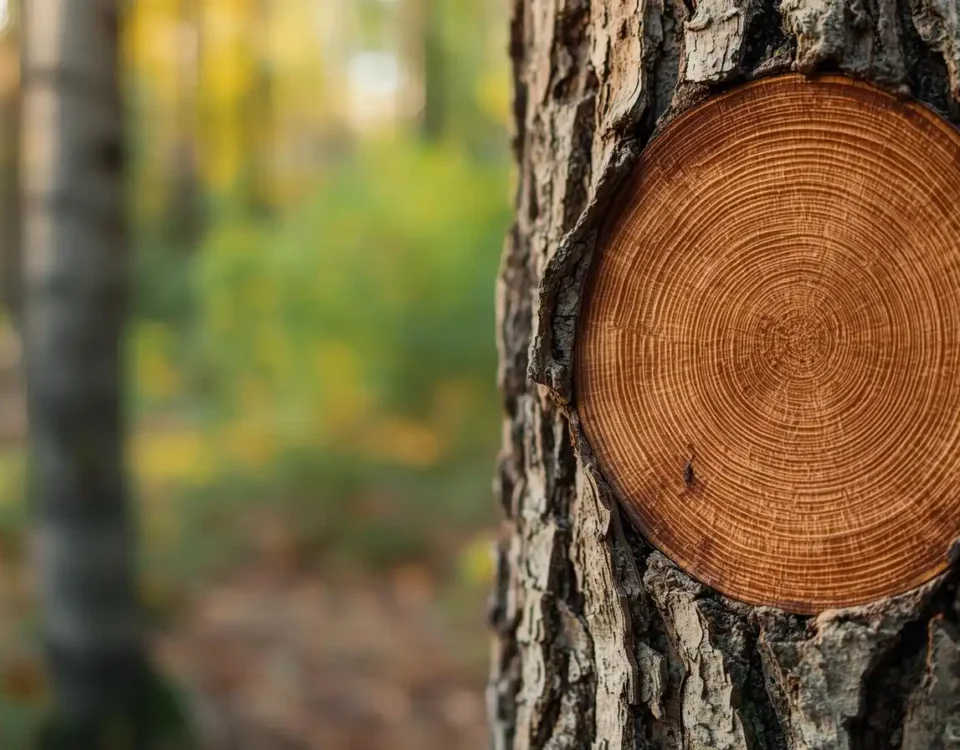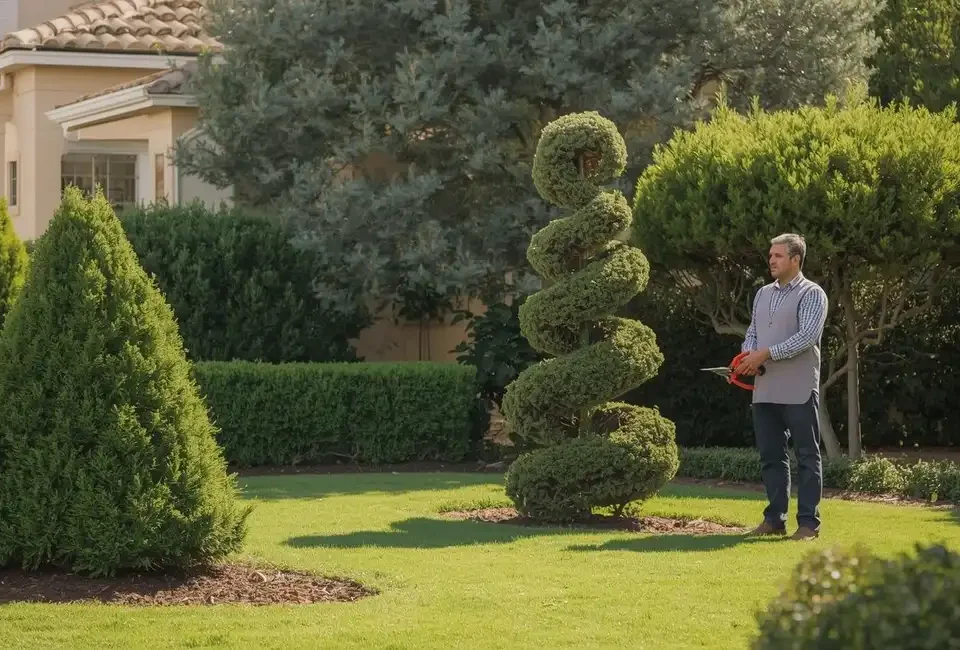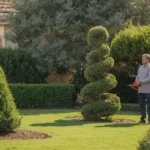
Mastering Tree Shapes A Homeowner’s Guide to Choosing, Creating, and Maintaining Pyramids, Lollipops, and Vases
October 28, 2025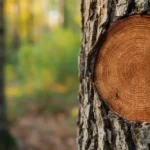
Tree Bark The Definitive Guide to Nature’s Ultimate Protective Barrier, Care & Uses
October 31, 2025Picture this: your kitchen bin is overflowing with peels, coffee grounds, and leftovers that could be doing so much more than just taking up space. Or maybe you’ve looked at your garden and wished for richer, healthier soil without relying on store-bought fertilizers. And then there’s that nagging feeling when you toss organic waste into the trash, knowing it’ll only add to a growing landfill problem. What if you could turn all that waste into something valuable, what gardeners lovingly call “gardener’s gold”?
Outdoor composting makes that possible. It’s more than just a way to manage waste; it’s a simple, natural process that rewards you with nutrient-rich compost to feed your plants, reduces what ends up in landfills, and helps you cultivate a thriving, chemical-free garden. With the right setup, anyone can transform everyday scraps into an eco-friendly powerhouse for their soil.
This guide will help you do exactly that. We’ll simplify your search by breaking down the top outdoor composters, reviewing their strengths, and comparing their features in plain language. By the end, you’ll know exactly which system fits your space, habits, and gardening goals. You’ll be ready to make a smart, sustainable choice that benefits both your garden and the planet.
Understanding Outdoor Composters: Types & Their Uses
The Basics of Composting: A Quick Primer
Composting is nature’s way of recycling. It transforms everyday organic waste, like fruit peels, leaves, and grass clippings, into rich, dark compost that feeds your soil. This natural process not only reduces what ends up in the landfill but also gives your garden a steady supply of nutrients.
So, what exactly is compost? It’s a crumbly, earthy material packed with organic matter that improves soil structure, boosts water retention, and encourages beneficial microorganisms to thrive. When mixed into your garden beds, compost helps plants grow stronger, retains moisture in dry spells, and even deters certain pests by improving overall soil health.
At its core, composting relies on the right mix of “greens” and “browns.” Greens are nitrogen-rich materials like vegetable scraps, coffee grounds, and grass clippings, while browns are carbon-rich materials such as dried leaves, wood chips, and cardboard. These two elements work together; nitrogen fuels microbial growth, and carbon provides energy and structure for decomposition.
Expert Tip: Always maintain a balanced carbon-to-nitrogen (C: N) ratio by layering nitrogen-rich greens with carbon-rich browns. This balance ensures steady decomposition and keeps your compost pile from smelling unpleasant or breaking down too slowly.
Miracle-Gro Dual Chamber Compost Tumbler – Easy-Turn, Heavy-Duty Outdoor Bin Composter with 2 Sliding Doors (2x18.5 Gal/70L
Description:
Stationary compost bins are the most traditional setup, simple, open-bottomed containers usually made of recycled plastic or wooden slats. You place them directly on the soil so earthworms and microorganisms can move in naturally.
Dual-Chamber Design for Continuous Use:
One chamber cures while you fill the other, ensuring a steady supply of compost without downtime perfect for serious gardeners.
Fast & Effortless Composting:
No need for manual turning or messy piles. The easy-rotate tumbler mixes compost evenly, speeding up decomposition to deliver ready-to-use compost in as little as 4–6 weeks.
Durable & Weather-Resistant Build:
Crafted with UV-protected, BPA-free plastic and a galvanized steel base, this tumbler is built for stability, longevity, and pest resistance designed to handle every season.
Ideal for:
Gardeners who produce large amounts of yard waste and prefer a low-maintenance system. These bins are perfect for passive composting, where time does most of the work.
Pros & Cons:
✅ Cost-effective and capable of handling large volumes.
✅ Minimal setup and no moving parts.
❌ Decomposition takes longer due to limited aeration.
❌ Requires occasional manual turning to keep the process active.
Compost Tumblers
Description:
Compost tumblers are sealed, rotating barrels mounted on a stand. Their main advantage lies in easy aeration; you simply spin the barrel to mix and oxygenate the materials.
Ideal for:
Home gardeners looking for faster composting results with moderate waste volumes. Tumblers are also great for keeping pests like rodents out.
- Faster composting thanks to regular aeration.
- Simple and clean, no need to handle the compost directly.
- Smaller capacity than stationary bins.
- Generally more expensive than basic models.
Worm Composters (Vermicomposting)
Description:
Worm composters are compact systems made up of stacked trays. Red wigglers or tiger worms live inside these trays and consume your kitchen scraps, producing highly nutritious worm castings, a powerful organic fertilizer.
Ideal for:
Urban gardeners or those with limited outdoor space. Perfect for handling kitchen waste rather than bulky garden debris.
- Produces incredibly nutrient-dense compost.
- Requires no turning and minimal odor.
- Sensitive to temperature changes and moisture levels.
- Not suitable for large yard waste or tough garden materials.
Worm Factory® Basic 3 Tray Black Worm Composter – US Made, Fully Assembled System for Home Food Waste Recycling.
The Worm Factory Basic Black 3-Tray System offers a compact, stackable design ideal for small to medium households. Easily expand or customize trays to fit your composting needs while efficiently recycling kitchen scraps into nutrient-rich compost.
Crafted from high-quality, USA-made plastic, this sturdy composter fits neatly in any indoor or outdoor space. Its sleek black finish blends effortlessly with modern home and garden settings.
The vertical tray design encourages worms to migrate upward as they process waste, leaving finished compost below for quick, mess-free harvesting. The built-in spigot makes managing moisture and collecting compost tea simple.
Hot Composters (Insulated Bins)
Description:
Hot composters are designed to hold heat. Their insulated walls trap warmth generated by decomposition, maintaining high internal temperatures that speed up the breakdown process.
Ideal for:
Gardeners who want compost quickly or wish to compost year-round, even in cooler climates. They’re also effective at killing weed seeds and plant pathogens due to the high heat.
- Rapid decomposition, compost in weeks instead of months.
- Effective against weeds and diseases.
- Higher cost compared to basic bins.
- Requires careful balancing of greens and browns to maintain optimal temperature.
EPICA Countertop Compost Bin Kitchen | 1.3 Gallon | Odorless Composting Bin with Carbon Filters | Indoor Compost Bin with Lid | Stainless Steel Kitchen Composter for Food Scraps & Waste Recycling
Trusted by home chefs and recognized by leading publications, the EPICA Compost Bin is perfectly sized for your kitchen countertop compact yet spacious enough to store several days’ worth of organic waste. Dimensions: 7.16" diameter x 11" height.
Keep your kitchen fresh with EPICA’s airtight lid and replaceable activated-charcoal filter, designed to trap and neutralize odors naturally no chemicals, no hassle.
Made from a single molded piece of stainless steel, this bin resists rust, leaks, and deterioration. Unlike welded models, it’s effortless to clean and built for long-term reliability.
Includes EPICA’s activated-charcoal filter, lasting up to six months with proper care. Enjoy convenient, odor-free composting right from your kitchen counter.
DIY Composter Solutions
Description:
For those who enjoy hands-on projects or want to save money, DIY composters are a practical choice. Common designs include pallet bins, wire mesh cages, or even repurposed barrels.
Ideal for:
Budget-conscious gardeners or anyone who wants to customize the size and setup of their composting system.
- Inexpensive and easy to build with readily available materials.
- Customizable for any garden size.
- May lack insulation or pest protection.
- Can require more effort to manage and maintain.
How We Chose the Best Outdoor Composters
Our Rigorous Selection Process
Choosing the right outdoor composter can be confusing with so many options on the market. To make this guide truly helpful, our recommendations come from a mix of hands-on testing, in-depth research, and expert consultation. Whenever possible, we assembled and tested composters ourselves to evaluate how they perform in real-world conditions. We also studied manufacturer specifications, compared design features, and analyzed hundreds of verified customer reviews to understand long-term performance and common issues. Finally, we consulted horticultural specialists and sustainable gardening experts to ensure our insights reflect both science and experience.
This combination of testing, research, and expert input allowed us to identify composters that excel not just on paper, but in actual gardens.
Our Evaluation Criteria
To narrow down the list to the best-performing composters, each model was assessed using the following key criteria:
- Durability & Material Quality
We looked at how each composter holds up against the elements: sun, rain, wind, and pests. UV resistance, rust-proof hardware, and the sustainability of materials (like recycled plastic or FSC-certified wood) were top considerations. - Capacity & Footprint
Different gardens have different needs. We evaluated how much waste each unit could handle and how efficiently it used space, from compact models suited for small patios to larger bins ideal for family gardens. - Ease of Use & Assembly
A good composter shouldn’t feel like a project every time you use it. We factored in how simple each model was to assemble, load, turn, and empty. Ergonomic handles, clear instructions, and thoughtful design details earned higher marks. - Pest Resistance
Rats, raccoons, and insects can be a major issue in outdoor composting. We tested how well each system sealed and whether the lids, latches, and bases kept pests out without restricting airflow. - Composting Efficiency
We assessed how quickly each unit broke down organic waste and whether it maintained the right balance of heat and moisture. Tumblers and hot composters often scored higher here, but even stationary bins performed well when properly managed. - Value for Money
We compared features, materials, and longevity relative to cost. The goal was to highlight composters that deliver the best return on investment, reliable performance at a fair price. - Aesthetics
While function always comes first, looks do matter. We considered how each composter fits into a garden setting, whether it blends naturally into the landscape or offers a clean, modern design.
Our Commitment to Objectivity
We take transparency seriously. All product recommendations in this guide are made with the reader’s best interests in mind. When affiliate links are included, they do not affect our editorial judgment or the ranking of products. Every composter featured here was chosen based on proven performance, verified customer satisfaction, and real usability, not marketing claims or brand partnerships.
You can trust that our goal is to help you make an informed, confident choice that genuinely benefits your garden and the environment.
The 7 Best Outdoor Composters for Your Garden (Detailed Reviews)
1. Dual-Chamber Compost Tumbler (e.g., Tumbleweed, Lifetime)
Product Recommendation: Dual-Chamber Compost Tumbler
Features:
This popular design features two separate chambers, allowing you to fill one while the other finishes decomposing. The sealed, rotating drum keeps compost aerated without needing a pitchfork, and the sturdy frame supports easy turning.
- Fast decomposition (achieves usable compost in 4–6 weeks under ideal conditions)
- Continuous composting cycle, one chamber always active.
- Excellent pest resistance due to sealed design
- Simple aeration with minimal effort
- Limited capacity per chamber It can be heavy to rotate when full
Ideal Use Case:
Perfect for medium-sized gardens with regular kitchen and garden waste. Great for those who want quick, consistent compost production without much manual labor.
2. Large Capacity Stationary Compost Bin (e.g., GEOBIN, Hot Frog)
Product Recommendation: Large Capacity Stationary Compost Bin
Features:
These bins use a simple, open-bottomed design, often made from durable plastic or mesh, that sits directly on the soil for natural microbial access. Many models are expandable, letting you increase capacity as your composting needs grow.
- Extremely cost-effective and easy to assemble
- Huge capacity for bulky yard waste
- Encourages natural decomposition through soil contact
- Slower composting due to limited aeration
- Requires manual turning
- Moderate pest resistance unless modified with a wire mesh base
Ideal Use Case:
Ideal for large gardens and anyone dealing with high volumes of leaves, trimmings, or grass clippings. Great for patient, budget-conscious composters.
Pest-Proofing Scorecard: Good. For best results, add a wire mesh base to deter rodents while allowing air circulation.
3. Compact Stationary Compost Bin (e.g., FCMP Outdoor IM4000)
Product Recommendation: Compact Stationary Compost Bin
Features:
A smaller, rigid plastic bin that fits neatly into tight garden spaces. Designed with a top-access lid for adding scraps and lower doors for removing finished compost.
- Compact and discreet, great for small spaces
- Easy to use and beginner-friendly
- Low-maintenance design
- Limited capacity for large gardens
- Requires manual turning with a fork or aerator
Ideal Use Case:
Perfect for small gardens, patios, or balconies. A great choice for first-time composters managing modest food and garden waste.
The Urban Composter's Guide: Maximizing Small Spaces with the Best Compact Outdoor Solutions.
4. Worm Composter / Vermicomposter (e.g., Worm Factory, Urbalive)
Product Recommendation: Worm Composter / Vermicomposter
Features:
Multi-tray design featuring aeration holes and a bottom spigot for collecting “compost tea”, a nutrient-rich liquid fertilizer. Worms naturally migrate upward as they finish processing each tray.
- Produces nutrient-rich worm castings
- Minimal odor when managed properly
- Fun and educational for families or kids
- Not suitable for large garden waste
- Sensitive to temperature changes
- Requires an initial investment in composting worms
Ideal Use Case:
Best for kitchen scraps and small outdoor areas. Ideal for those who want high-quality organic fertilizer and a compact, odor-free system.
Expert Tip: Start with an activator, a layer of existing compost, soil, or a commercial starter, to introduce beneficial microbes and speed up the breakdown process.
5. Insulated Hot Composter (e.g., Joraform, Green Cone)
Product Recommendation: Insulated Hot Composter
Features:
Thick insulation maintains high internal temperatures, speeding up decomposition and allowing year-round use. Many are elevated to improve airflow and include dual chambers for continuous composting.
- Rapid composting, even in cold climates
- Handles more types of waste, including cooked food
- Convenient, rapid access to technology
- Sanitizes compost by killing weed seeds and pathogens
- Higher initial investment
- A bulky design may need extra space.
- Requires careful balancing of materials to maintain heat
Ideal Use Case:
Great for dedicated composters producing large amounts of organic waste who want fast, reliable results throughout the year.
Expert Tip: Monitor internal temperatures between 130°F–160°F (54°C–71°C) to ensure optimal microbial activity and pathogen control. Regular turning and moisture checks help maintain these conditions.
6. Rolling Compost Cart/Bin (e.g., YIMBY Tumbler Composter)
Product Recommendation: Rolling Compost Cart/Bin
Features:
This portable design combines the benefits of a tumbler with mobility. Often mounted on wheels, it allows easy relocation and direct transport of compost to garden beds.
- Convenient mobility for spreading compost
- Ideal for smaller spaces
- Clean and simple operation
- Smaller capacity than traditional bins
- It can be harder to roll when fully loaded.
Ideal Use Case:
Perfect for gardeners who like to move compost easily between beds or have limited storage space.
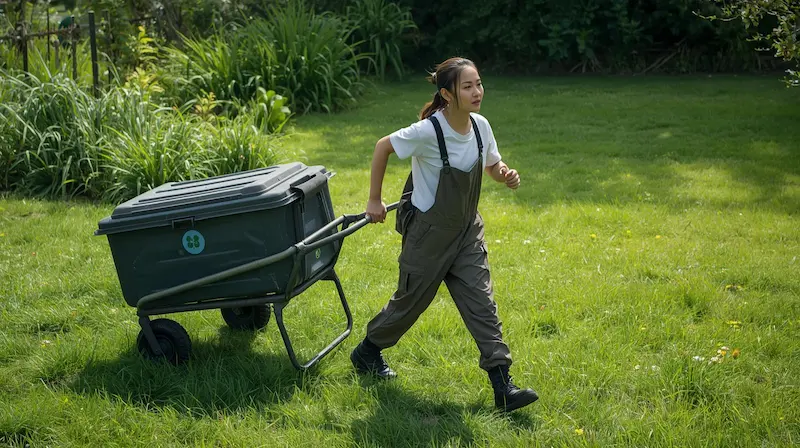
7. DIY Composter Kits/Plans
Product Recommendation: DIY Composter Kits/Plans
Features:
These kits or plans let you build your own compost system using materials like pallets, chicken wire, or lumber. Designs range from simple one-bin setups to more advanced three-bin systems for batch composting.
- Rewarding hands-on project
- Highly affordable and customizable
- Sustainable, can repurpose existing materials
- Requires tools, time, and effort
- May need pest-proofing or reinforcement
- Durability varies depending on the materials used.
Ideal Use Case:
Ideal for budget-conscious gardeners or those who enjoy DIY projects. Great for tailoring a composter to your garden’s exact size and needs.
An in-depth material comparison, pressure-treated wood offers strength and longevity, while recycled plastic is lightweight, eco-friendly, and resistant to rot.
|
Composter Model |
Type |
Capacity (Gallons / Litres) |
Key Features |
Pros |
Cons |
Ideal For |
Pest Resistance |
|
Dual-Chamber Tumbler |
Tumbler |
~37-45 gal / ~140-170 L* |
Two chambers for continuous use, a high-quality plastic or steel frame |
Fast composting, easy turning, continuous supply |
Higher cost; can be heavy when full |
Medium gardens with consistent waste, fast turnaround |
Good – sealed design helps keep pests out |
|
GEOBIN Composter |
Stationary Bin |
~80-200 gal / ~300-750 L* |
Expandable design, open bottom for soil contact, durable plastic or mesh |
Large capacity, economical, simple to set up |
Slower decomposition, manual turning needed |
Large gardens with high yard waste |
Moderate – open bottom needs extra pest-proofing |
|
FCMP Outdoor IM4000 |
Stationary Bin |
~65 gal / ~246 L* |
Compact rigid plastic, easy access lid |
Space-saving, good for beginners |
Smaller capacity, still manual turning |
Small gardens, urban settings, modest waste |
Fair – decent slats/lid, might need rodent deterrents |
|
Worm Factory 360 |
Worm Composter (Vermicomposting) |
Multi-tray (4-8 trays) rather than gallons |
Multi-tray system, aeration holes, “compost tea” spigot |
Excellent for kitchen scraps, rich castings |
Not for bulky garden waste, sensitive to conditions |
Kitchen waste, small outdoor area, high-nutrient focus |
Good – enclosed trays help, but surface access needs control |
|
Joraform JK270 (Insulated Hot Composter) |
Hot Composter |
Thick insulation, dual chamber, rodent-proof steel panels |
Very fast composting, handles diverse waste year-round |
High upfront cost; bulky; requires good management |
Dedicated composters wanting rapid results, diverse waste |
Very good – elevated stand, sealed, steel construction |
|
|
YIMBY Tumbler Composter (Rolling Cart) |
Rolling Tumbler |
~37 gal / ~140 L* |
On wheels, portable design, single chamber, often |
Easy to relocate compost, convenient in moving garden setups |
Smaller capacity; heavy when full to roll |
Smaller gardens with a need for mobility |
Fair – depends on design, wheel frame may open access |
|
DIY Pallet Bin |
Stationary Bin (DIY) |
Variable (100-300+ gal) |
Custom-built from pallets/wire/wood/lumber |
Cost-effective; customizable size; satisfying project |
Requires tools/time; variable durability; less pest-proof |
Budget-conscious, DIY-friendly gardeners, custom garden size |
Variable – depends entirely on build quality and pest-proofing |
*Note: Capacities are approximate and based on exemplar models; please verify specific model specs in your locale.
Key Notes & Recommendations:
- For each capacity figure, I found varying numbers in sources (for instance, the JK270 is listed as ~70 gal / ~9.5 cu ft by some sources).
- Pest resistance is especially important in outdoor settings. Look for sealed lids, elevated designs (especially for rodent control), and durable material that resists weather and UV.
- Even in a “large capacity” bin, if aeration/turning is weak, the composting speed will suffer. So capacity alone isn’t everything.
- Local climate and waste habits matter: e.g., hot composters shine in cooler weather or where you produce lots of food waste; stationary bins are simpler but slower; tumblers are a good middle ground.
Factors to Consider When Choosing an Outdoor Composter
Choosing the right outdoor composter isn’t just about size or price. It’s about finding the system that fits your space, waste habits, and lifestyle. Here’s a practical look at the key factors to help you make the best decision.
1. Garden Size & Available Space
Your available space sets the stage for the type of composter that will work best.
- Small Spaces: If you have a small yard or patio, a compact tumbler or vertical worm bin can be ideal. They’re efficient, tidy, and don’t take up much room.
Larger Gardens: For those with ample space, large stationary bins or dual-chamber tumblers offer more capacity to handle big volumes of yard waste.
Many gardeners struggle with limited garden space and want a compact solution that still produces high-quality compost.
2. Volume & Type of Waste
Consider what kind of organic waste you generate most often.
- Kitchen Scraps: Fruit peels, coffee grounds, and vegetable trimmings are ideal for tumblers or worm bins.
- Yard Waste: If your waste includes grass clippings, leaves, or small branches, go for a larger bin or multi-chamber system.
Balancing your “greens” (nitrogen-rich materials) with “browns” (carbon-rich materials) ensures efficient decomposition and reduces odor.
Expert Tip: Chop Materials Smaller. The smaller the pieces, the faster they decompose. Shred leaves and cut up tough vegetable stalks before adding them to the mix.
3. Desired Composting Speed & Effort Level
Composting can be fast and active or slow and hands-off; it depends on how much time you’re willing to put in.
- Fast (Hot Composting): Tumblers and insulated bins accelerate decomposition and can produce usable compost within weeks.
Slow (Cold Composting): Stationary bins and pile systems take longer but require less daily attention.
Some gardeners find turning or aerating compost physically difficult, especially when bins are large or heavy. Tumblers help solve this by making the process much easier.
4. Budget & Durability
Composters range from affordable DIY setups to premium models with high-end features.
- Upfront Cost vs. Longevity: While cheaper bins can get you started, investing in a durable, UV-resistant plastic or galvanized metal model often pays off long term.
- Climate Considerations: In hot, sunny regions, UV resistance matters. In colder climates, insulated designs maintain microbial activity year-round.
Many buyers worry about spending too much on a composter that cracks, rusts, or fails to deliver results.
5. Pest Resistance & Odor Control
No one wants to deal with unwanted visitors or unpleasant smells.
- Pest-Resistant Designs: Tumblers and worm bins with sealed lids prevent rodents and insects from entering. Stationary bins benefit from wire mesh bases and tight-fitting lids.
Odor Control: Proper aeration and balanced materials (greens and browns) keep smells under control.
Gardeners, especially in urban or suburban areas, often worry about pests and odors making composting inconvenient.
Include a “Pest-Proofing Scorecard” in your comparison section, rating each composter type on its ability to resist rodents, flies, and other pests.
Expert Tip: Pest Prevention: Always secure the lid tightly. Use a wire mesh under stationary bins to block rodents, and avoid adding food like meat, dairy, or oily leftovers that attract pests.
6. Ease of Assembly & Maintenance
If you prefer simplicity, look for composters that are quick to assemble and easy to clean.
- Quick Assembly: Some models snap together in minutes, while others require tools and multiple parts.
- Maintenance: Tumblers need occasional cleaning, while stationary bins require manual turning and clearing out finished compost.
The easier your system is to maintain, the more likely you are to use it consistently.
7. Aesthetics
While functionality comes first, how your composter looks can also matter, especially if it’s visible in your yard.
Modern composters often come in neutral colors or sleek designs that blend in with garden décor. A well-chosen model can complement your outdoor space rather than stand out awkwardly.
Getting Started: A Basic Guide to Using Your Outdoor Composter
Once you’ve chosen the right outdoor composter, it’s time to put it to work. Composting isn’t complicated, but following a few simple steps will make the process smoother, cleaner, and far more productive.
1. Strategic Placement
Where you put your composter can make a big difference. The ideal spot is shaded, well-drained, and easy to reach year-round. Shade helps prevent the compost from drying out too quickly, while a well-drained surface stops water from pooling underneath. Keep it close enough to your kitchen or garden so it’s convenient to use, but not right beside outdoor seating areas.
Expert Tip: Strategic Placement: Locate your composter in a shaded, well-drained area of your garden, easily accessible but not directly in the scorching sun, which can dry it out too quickly.
2. Initial Setup & Layering
Think of your compost pile as a “lasagna” made of alternating layers of browns (carbon-rich materials) and greens (nitrogen-rich materials).
- Start with a base layer of coarse browns such as twigs, straw, or dry leaves to encourage airflow from below.
- Add greens next, such as vegetable peels or grass clippings. Continue alternating these layers as you add waste over time.
- Add an activator, a handful of soil, finished compost, or a commercial compost starter to introduce beneficial microbes that jumpstart decomposition.
This layering system keeps your pile balanced and prevents it from turning soggy or smelly.
3. What to Compost (and What to Avoid)
Knowing what can and can’t go into your composter is one of the most common challenges for beginners.
You Can Compost:
- Fruit and vegetable scraps
- Coffee grounds and tea bags
- Eggshells
- Grass clippings and leaves
- Straw, wood chips, and shredded paper
Avoid Composting:
- Meat, fish, or dairy products
- Oily or greasy foods
- Diseased plants
- Pet waste
- Chemically treated wood
Many people feel uncertain about what’s safe to compost. Adding the wrong materials can slow decomposition or attract pests.
Expert Tip: Avoid Problematic Items: Steer clear of meat, dairy, oily foods, and diseased plants to prevent odors, pests, and pathogen spread.
4. Maintaining Your Composter
Regular maintenance keeps your compost healthy and active. A little attention goes a long way.
Moisture: Your compost should feel like a wrung-out sponge, moist but not dripping wet.
- Too dry, and decomposition slows down.
- Too wet, and it can become smelly and slimy.
Expert Tip: Maintain Moisture Levels: Your compost pile should feel like a wrung-out sponge. Too dry, and decomposition slows; too wet, and it can become anaerobic and smelly.
Aeration/Turning: Oxygen is vital for the microbes that break down organic matter.
- For tumblers: Turn every 2–3 days to keep the material mixed and aerated.
- For bins: Use a compost aerator, garden fork, or shovel to stir the pile once a week. This prevents compaction and speeds up decomposition.
Expert Tip: Turn Regularly: For tumblers, turn every 2–3 days. For bins, aerate weekly with a compost aerator or pitchfork to keep the process active.
Balancing Greens and Browns: Keep roughly two parts browns to one part greens. If your pile smells bad, it likely has too many greens. If it’s not breaking down, you may need more greens or moisture.
5. Knowing When Your Compost is Ready
Finished compost looks, feels, and smells like rich, healthy soil. You’ll know it’s done when it’s dark brown, crumbly, and has an earthy scent. It should no longer contain visible food scraps or plant pieces.
Expert Tip: Know When It’s Ready: Finished compost is dark brown, crumbly, and has an earthy smell. It should no longer have recognizable food or plant scraps.
How to Harvest:
- Tumblers and bins with bottom doors make it easy to scoop out finished compost while newer materials continue decomposing above.
- For open bins or DIY setups, you can sift the compost to separate the fine, ready material from larger, unfinished bits. Those can go back into the pile for further breakdown.
Troubleshooting Common Composting Problems
Even the best composters run into a few hiccups. The good news is that most issues are simple to fix once you understand what’s causing them. Here’s how to identify and correct the most common composting problems before they spiral into a bigger mess.
Problem: Foul Odors
Cause: Too many “greens” (like food scraps or grass clippings), excess moisture, or poor aeration.
When your compost starts to smell rotten or sour, it’s a sign the pile has gone anaerobic, meaning there isn’t enough oxygen for healthy decomposition.
Solution:
- Add more “browns” such as dry leaves, cardboard, or shredded paper to absorb moisture.
- Turn or aerate the pile to restore airflow.
- Check that the bin has good drainage and isn’t sitting in a waterlogged spot.
Audience Pain Point: Many people worry about unpleasant odors or attracting pests, especially in smaller gardens or urban settings. Proper balance and aeration will keep your compost fresh and earthy, not foul.
Problem: Slow Decomposition
Cause: The compost is too dry, has too many browns, lacks oxygen, or is affected by cold temperatures.
A sluggish pile can be discouraging, especially when you’re expecting results within weeks.
Solution:
- Add moisture until it feels like a wrung-out sponge.
- Mix in more greens to boost nitrogen and microbial activity.
- Turn more often to add oxygen.
- Chop materials smaller to speed up breakdown.
Audience Pain Point: Many composters get frustrated when their pile just sits there. Remember, decomposition is a biological process; small tweaks in balance and aeration can dramatically speed it up.
Problem: Attracting Pests (Rodents, Flies, Ants)
Cause: Exposed food scraps, adding problematic items (like meat or dairy), or an unsecured lid.
Rodents and insects are drawn to easy food sources, especially in warm conditions or open bins.
Solution:
- Bury food scraps under a layer of browns.
- Avoid adding meat, dairy, or oily foods.
- Secure the lid tightly after each use.
- For stationary bins, install a wire mesh base to block burrowing pests.
Expert Tip: Pest Prevention: Ensure your composter has a secure, tight-fitting lid and consider a wire mesh base for stationary bins to deter rodents. Avoid adding attractive food waste that pests love.
Problem: Compost is Slimy or Mushy
Cause: Too much moisture and not enough airflow.
This usually happens when there’s an overload of wet materials like fruit scraps or grass clippings.
Solution:
- Mix in more dry browns to absorb excess moisture.
- Turn thoroughly to introduce oxygen and restore balance.
After a few turns, the texture should return to a loose, crumbly consistency.
Problem: Compost is Dry and Dusty
Cause: Lack of moisture or excessive browns.
Dry compost slows decomposition because microbes can’t thrive without enough water.
Solution:
- Add water gradually while mixing until it feels moist but not soggy.
- Cover the pile with a lid, tarp, or layer of browns to retain moisture.
If you live in a hot or windy climate, check your compost’s moisture weekly; it can dry out faster than you expect.
Frequently Asked Questions About Outdoor Composters
Conclusion: Cultivating a Greener Garden
Outdoor composting offers more than just a way to manage kitchen scraps and yard waste; it’s a simple yet powerful step toward a healthier, more sustainable garden. By exploring the diverse options of composters, from compact worm bins to large stationary systems, you can choose the one that fits your garden size, waste habits, and lifestyle. Balancing greens and browns, maintaining moisture, and turning your pile regularly are all straightforward steps that make the composting process easy and rewarding.
The benefits go far beyond convenience. Compost enriches your soil, improves water retention, supports vibrant plant growth, reduces the amount of organic waste sent to landfills, and contributes to environmental sustainability. It’s a small effort with a lasting impact.
Take Action Today: Use this guide to select your ideal composter and start your composting journey. Experiment, adjust, and watch your garden flourish. Share your experiences and inspire others to create their own patch of green.


